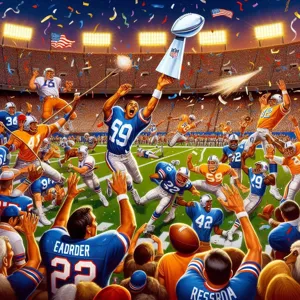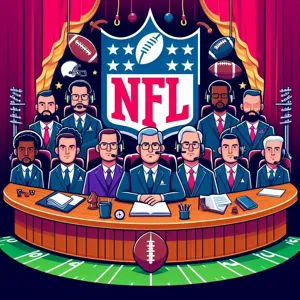The Super Bowl is more than just a championship game; it’s a cultural phenomenon that unites millions of fans across the globe in celebration of sportsmanship, rivalry, and unforgettable moments.
From jaw-dropping touchdowns to nail-biting finishes, each Super Bowl has etched its own unique chapter in the annals of football history, showcasing not only athletic prowess but also the resilience and spirit of the teams and their fans. As we dive into the remarkable stories behind the most iconic plays, legendary performances, and heart-stopping drama, prepare to relive the excitement that has defined this grand spectacle over the years. Join us as we journey through time, exploring those unforgettable moments that have made the Super Bowl a hallmark of American sports, igniting passion and nostalgia in the hearts of fans everywhere.
1. Introduction: The Significance of the Super Bowl

The Super Bowl is more than just a game; it’s a cultural phenomenon that unites millions across the globe in a shared celebration of sport, excellence, and entertainment. Each year, the championship game of the National Football League (NFL) captivates audiences with its thrilling matchups, high-stakes drama, and unforgettable halftime performances. The significance of the Super Bowl transcends the football field, becoming a stage where legends are born, rivalries are reignited, and history is made.
From nail-biting comebacks to stunning upsets, the Super Bowl has etched its moments into the annals of sports history, making it a cherished event that evokes nostalgia and passion. Fans gather around televisions or fill stadiums, donning their team colors and rallying together to cheer for their heroes. The atmosphere is electric, charged with anticipation and excitement, as the world tunes in to witness the culmination of an entire season’s hard work and dedication.
Moreover, the Super Bowl is a showcase for creativity and innovation, with advertisers vying for attention through clever commercials that often become as memorable as the game itself. This unique blend of sports and entertainment creates a tapestry of experiences that resonate with people from all walks of life. Whether you are a die-hard football enthusiast or simply enjoy the spectacle, the Super Bowl offers something for everyone, making it a hallmark of American culture.
As we delve into the unforgettable moments that have defined Super Bowl history, we will explore the plays, players, and performances that have left an indelible mark on fans and the sport alike. From the legendary moments that inspired a generation to the emotional highs and lows that capture the essence of competition, these snapshots in time remind us why the Super Bowl holds such a special place in our hearts.
2. The First Super Bowl: A Historical Overview
The first Super Bowl, played on January 15, 1967, remains a pivotal moment in sports history, setting the stage for what would become one of the most anticipated events in American culture. Officially known as Super Bowl I, this inaugural championship game brought together the champions of the National Football League (NFL) and the American Football League (AFL) in a matchup that would lay the groundwork for the future of professional football.
Held at the Los Angeles Memorial Coliseum, the atmosphere was electric, with a crowd of 61,946 fans brimming with excitement and curiosity. The game featured the Green Bay Packers, led by the legendary coach Vince Lombardi, facing off against the AFL champion Kansas City Chiefs. From the outset, it was clear that the Packers were the dominant force. With a blend of skillful plays and strategic prowess, they secured a commanding 35-10 victory, showcasing the prowess of future Hall of Famers like Bart Starr and Paul Hornung.
Beyond the score, Super Bowl I was marked by its historic significance. It was the first time two leagues had come together to determine a champion, and it set the precedent for future matchups that would enthrall millions. The broadcast, which aired on two networks—NBC and CBS—drew an estimated audience of 24 million viewers, a staggering number for that time, highlighting the game’s potential as a cultural phenomenon.
The halftime show was a modest affair compared to today’s extravagant productions, featuring a marching band and a brief performance by the Grambling State University Band. Yet, it was a glimpse into the future of Super Bowl entertainment, hinting at the grand spectacles that would come to define the event in the decades to follow.
As the first Super Bowl came to a close, it marked not only a victory for the Packers and the NFL but also the birth of a tradition that would evolve into an annual celebration of sport, entertainment, and community. The echoes of that historic day continue to resonate, reminding fans of the enduring legacy that began with a single game—a moment that forever changed the landscape of American sports.
3. The “Immaculate Reception”: A Defining Play

The “Immaculate Reception,” a moment that transcended the game of football and etched itself into the annals of Super Bowl history, occurred on December 23, 1972, during an AFC playoff game between the Pittsburgh Steelers and the Oakland Raiders. As the clock wound down in a tense fourth quarter, the stakes were monumental. The Steelers, a team traditionally plagued by misfortune, found themselves trailing 7-6 with only 22 seconds left on the clock.
What happened next would forever change the course of the franchise and the sport itself. Quarterback Terry Bradshaw, under immense pressure from the Raiders’ formidable defense, released a desperate pass intended for running back Frenchy Fuqua. The ball ricocheted off Fuqua’s hands and, in a miraculous twist of fate, bounced into the path of Steelers’ fullback Franco Harris. With a swift and instinctive motion, Harris scooped the ball up just inches from the turf and sprinted into the end zone, securing a stunning 13-7 victory for Pittsburgh.
The “Immaculate Reception” not only marked the Steelers’ first playoff win in franchise history but also ignited a dynasty that would define the NFL in the 1970s. This defining play became a symbol of hope and resilience, illustrating the unpredictable nature of sports. Fans still debate the legitimacy of the catch and the rules governing that fateful moment, but one thing is clear: the “Immaculate Reception” remains a cornerstone of Super Bowl lore, embodying the thrill, drama, and magic that can unfold on the gridiron. It is a reminder that in football, as in life, the unexpected can lead to unforgettable triumphs.
4. The “Hail Mary” Moment: Roger Staubach’s Legacy
The “Hail Mary” moment is more than just a phrase; it’s a defining moment etched in the annals of Super Bowl history, encapsulating the spirit of hope and the thrill of the unexpected. At the heart of this legendary play is none other than Roger Staubach, a quarterback whose name has become synonymous with clutch performances and audacious plays.
It was the 1975 NFC Divisional Playoff game against the Minnesota Vikings, a matchup that would set the stage for Staubach’s iconic reputation. With just seconds remaining on the clock, and the Dallas Cowboys trailing by a mere four points, the situation seemed dire. The Cowboys were on their own 50-yard line, and the air was thick with tension. Staubach, displaying poise under pressure, dropped back to pass, surveying the field for any glimmer of opportunity.
With defenders closing in, he launched a desperate throw toward the end zone, a prayer sent to the football gods. The ball soared through the air, a beautiful arc of sheer audacity, and somehow found its way into the hands of Drew Pearson, who had managed to shake off his defender. The crowd erupted as the Cowboys secured a stunning 17-14 victory, sealing Staubach’s reputation as a game-changing quarterback and giving birth to the term “Hail Mary.”
This moment not only solidified Staubach’s legacy as one of the greatest quarterbacks in NFL history but also transformed the way players and fans viewed the potential of a last-minute play. The “Hail Mary” has since evolved into a strategy that embodies the unpredictability and excitement of football, reminding us all that even in the direst of circumstances, magic can happen on the field. Staubach’s audacity and skill became inspirations for countless players, reinforcing the idea that sometimes, a leap of faith is all it takes to create an unforgettable moment. As we reflect on Super Bowl history, the “Hail Mary” remains a testament to the enduring power of belief, resilience, and the unyielding spirit of competition.
5. The “Helmet Catch”: A Game-Changing Play

When we think of iconic Super Bowl moments, few plays resonate as deeply as David Tyree’s unforgettable “Helmet Catch” during Super Bowl XLII. It was February 3, 2008, a crisp winter evening in Glendale, Arizona, where the New York Giants faced off against the heavily favored New England Patriots, who were on the brink of completing a perfect season. The stakes were monumental, and the tension was palpable.
As the fourth quarter ticked down, the Giants were trailing by four points, and their hopes of clinching the championship seemed to dwindle with each passing second. The team found itself backed against the wall, facing a daunting third down with just over a minute left on the clock. Quarterback Eli Manning, with the weight of the world on his shoulders, dropped back to pass. The Patriots’ defense swarmed around him, but in a moment of sheer determination, Manning eluded what seemed like an inevitable sack.
With time running out and pressure mounting, he launched a desperate throw downfield. Enter Tyree, who was tightly covered by cornerback Rodney Harrison. In what can only be described as a blend of skill, tenacity, and a touch of magic, Tyree managed to catch the ball not with his hands but with the very top of his helmet, cradling it against his head as he fell to the ground. The stadium erupted in disbelief and exultation—what had just transpired was nothing short of miraculous.
This game-changing play not only kept the Giants’ drive alive, but it also set the stage for a stunning game-winning touchdown just moments later. The Giants ultimately triumphed, dethroning the Patriots and sealing their place in Super Bowl lore. The “Helmet Catch” is more than just a highlight; it symbolizes resilience and the unpredictability of sports. It serves as a poignant reminder that in the world of the Super Bowl, anything can happen—especially when the stakes are at their highest.
6. The Impact of Janet Jackson’s Halftime Show
The Super Bowl halftime show has long been a spectacle, but few performances have sparked as much conversation and controversy as Janet Jackson’s iconic appearance during Super Bowl XXXVIII in 2004. This moment transcended the realm of entertainment, leaving an indelible mark on pop culture and the broadcasting landscape.
As Jackson took the stage alongside Justin Timberlake, anticipation buzzed through the stadium. The duo delivered a high-energy performance filled with electrifying choreography and chart-topping hits, culminating in a shocking finale that would become the defining moment of the event. As Timberlake pulled away part of Jackson’s costume, millions of viewers were stunned to witness a flash of skin—a wardrobe malfunction that would ignite a media frenzy and lead to widespread discussions about censorship and decency in broadcasting.
The aftermath was swift and sweeping. In the days that followed, the Federal Communications Commission (FCC) faced an avalanche of complaints, leading to a hurried tightening of broadcasting regulations. Networks, fearing hefty fines, became more cautious about content, and the term “wardrobe malfunction” entered the public lexicon, forever associated with that fateful performance.
More than just a moment of controversy, Jackson’s halftime show has since been seen as a pivotal point in Super Bowl history, one that shifted the narrative around halftime entertainment. It prompted a reevaluation of artistic expression, and in many ways, set the stage for the evolution of future performances. Artists became more aware of their potential impact, as the Super Bowl transitioned from a mere sports event into a high-stakes platform for cultural commentary.
In retrospect, Janet Jackson’s performance was not just a fleeting moment of shock; it was a catalyst for change that shaped how the Super Bowl was viewed and experienced in subsequent years. It serves as a reminder of the power of live television and the unforgettable moments that can define an era.
7. The “28-3 Comeback”: Atlanta Falcons vs. New England Patriots

The “28-3 Comeback” is etched into Super Bowl lore as one of the most dramatic turnarounds in sports history. On February 5, 2017, the Atlanta Falcons faced off against the New England Patriots in Super Bowl LI, and as the game unfolded, it seemed destined to become the Falcons’ crowning achievement. With a commanding lead of 28-3 early in the third quarter, Atlanta appeared poised to secure its first-ever Super Bowl title. The dynamic offense, led by quarterback Matt Ryan, showcased a relentless attack, leaving fans and analysts alike in awe of their performance.
However, the tides began to turn when the Patriots, renowned for their resilience, launched an incredible comeback led by legendary quarterback Tom Brady. As the seconds ticked away, the Falcons’ defense faltered under the pressure. With each passing play, the once-comfortable lead began to evaporate, and the Patriots showcased their unparalleled poise in high-stakes situations. Brady orchestrated a series of methodical drives, culminating in two touchdown passes that narrowed the score, igniting hope among Patriots fans.
As the fourth quarter unfolded, the unthinkable became reality. Atlanta’s offense, which had been so dominant, struggled to regain its momentum, facing a relentless Patriots defense. With the game tied at 28-28, a first in Super Bowl history, the match headed into overtime—a first for the NFL championship. In this nerve-wracking extra period, the Patriots made quick work of the Falcons, sealing their victory with a touchdown run from James White.
The final score of 34-28 not only marked the Patriots’ fifth Super Bowl title but also solidified Tom Brady’s legacy as one of the greatest quarterbacks of all time. For Falcons fans, the haunting memory of the “28-3 Comeback” remains a painful reminder of a game that slipped away, while for Patriots supporters, it stands as a testament to the power of perseverance and belief. This unforgettable moment is a quintessential example of the unpredictable nature of football, where hope can flicker and flames can reignite in the blink of an eye.
8. The Rise of the Underdogs: Memorable Upsets
In the grand tapestry of Super Bowl history, few narratives captivate fans quite like the rise of the underdogs. These unforgettable upsets remind us that in the world of sports, anything is possible, and they often serve as a testament to the indomitable spirit of perseverance, teamwork, and sheer willpower.
Take, for instance, the iconic Super Bowl III in 1969, where the New York Jets faced off against the heavily favored Baltimore Colts. With a charismatic Joe Namath boldly guaranteeing victory, the Jets defied all odds, securing a stunning 16-7 win. This shocking upset not only earned them their first championship but also solidified Namath’s legendary status and changed the perception of the AFL in the eyes of the football world.
Fast forward to Super Bowl XLII in 2008, where the New England Patriots, riding a perfect season and a wave of confidence, were pitted against the New York Giants. The Giants, considered heavy underdogs, had edged their way into the championship with a string of close victories. Yet, on that fateful day, they delivered a performance for the ages, culminating in a breathtaking 17-14 victory that featured the unforgettable “Helmet Catch” by David Tyree. This game not only prevented the Patriots from a flawless season but also etched the Giants’ name in Super Bowl lore.
Then there was Super Bowl LII, which saw the Philadelphia Eagles soar against the favored Patriots. With backup quarterback Nick Foles at the helm, the Eagles executed a daring game plan that included the famous “Philly Special,” a trick play that resulted in a touchdown pass to Foles himself. This bold strategy, combined with the Eagles’ relentless determination, led to a 41-33 victory, delivering the franchise its first Super Bowl title and sending their passionate fans into a frenzy.
These moments showcase the beauty of the underdog narrative — a reminder that skill, heart, and belief can sometimes triumph over overwhelming odds. Each upset not only reshapes the championship landscape but also cements its place in the hearts of fans, serving as a beacon of hope and inspiration for teams and supporters alike. As we celebrate these remarkable upsets, we are reminded of the unpredictability of sports and the unforgettable stories that unfold on the grandest stage of all.
9. Iconic Super Bowl MVP Performances
The Super Bowl has always been a stage where legends are born, and nothing embodies this more than the unforgettable performances of its Most Valuable Players (MVPs). These moments are etched in the annals of sports history, where individual brilliance shines through the collective efforts of a team. From last-minute heroics to record-breaking displays of athleticism, the MVP performances have captivated fans and left an indelible mark on the game.
Take, for example, Joe Namath’s audacious guarantee in Super Bowl III, where he boldly proclaimed victory for the New York Jets against the heavily favored Baltimore Colts. Namath not only led his team to a stunning 16-7 upset but also delivered a performance that embodied confidence and charisma, earning him the MVP title and forever changing the perception of the Jets and the game itself.
Fast forward to Super Bowl XLIX, where New England Patriots quarterback Tom Brady demonstrated why he is often regarded as the greatest of all time. In a nail-biting finish against the Seattle Seahawks, Brady orchestrated a comeback for the ages, culminating in a game-winning touchdown drive. His poise under pressure and ability to perform when it mattered most secured his third Super Bowl MVP award and solidified his legacy.
Another unforgettable moment came during Super Bowl LII, when Philadelphia Eagles quarterback Nick Foles stepped into the spotlight. In a stunning upset against the Patriots, Foles not only threw for 373 yards and three touchdowns but also caught a touchdown pass in a trick play dubbed the “Philly Special.” His fearless performance inspired a city and brought the Eagles their first Super Bowl title, making him an unlikely MVP hero.
These iconic performances are not just about statistics; they are narratives of grit, determination, and the spirit of competition. Each MVP has left an imprint on the Super Bowl’s storied history, reminding us that this grand stage is where dreams come true, and legends are immortalized. As fans, we cherish these moments, reliving the drama and excitement that only the Super Bowl can deliver.
10. The Evolution of Super Bowl Commercials
The Evolution of Super Bowl Commercials
Super Bowl commercials have transcended mere marketing to become cultural phenomena in their own right, captivating audiences and sparking conversations long after the final whistle. From their humble beginnings as simple ads vying for viewer attention amidst the game, these commercials have evolved into elaborate productions with star-studded casts, high budgets, and innovative storytelling.
In the early years of the Super Bowl, advertisers treated their time slots as a necessary expense rather than a unique opportunity. The commercials were straightforward and often gimmicky, focusing primarily on product features and brand logos. However, as the Super Bowl’s popularity skyrocketed, so did the stakes for advertisers. Brands began to recognize that a well-crafted ad could not only boost sales but also elevate their standing in the public eye.
Fast forward to the present day, and Super Bowl commercials have transformed into elaborate spectacles that rival the game itself. Companies spend millions for just a 30-second spot, and the competition for attention is fiercer than ever. Brands pull out all the stops—think celebrity cameos, unexpected twists, and emotionally resonant narratives. The commercials often tackle social issues, push boundaries, and even spark debates, leaving viewers buzzing with opinions and reactions.
For example, memorable ads like Apple’s “1984” and Budweiser’s “Whassup?” have become ingrained in popular culture, demonstrating the power of creativity and humor in advertising. In recent years, brands have also embraced digital platforms, releasing teaser trailers and interactive content that engage audiences before and after the game.
As we look to the future, the evolution of Super Bowl commercials continues to unfold. With advancements in technology and a growing emphasis on social media integration, brands are finding new ways to connect with consumers. Whether through augmented reality experiences or real-time audience engagement, the landscape of Super Bowl advertising is ever-changing, promising even more unforgettable moments in the years to come. As we celebrate the rich history of the Super Bowl, it’s clear that the commercials have become as integral to the experience as the game itself.
11. The Role of Coaches in Super Bowl History
The Super Bowl is not just a showcase of athletic prowess; it is a grand theater where the minds behind the game—the coaches—play a pivotal role in crafting unforgettable moments. From strategic genius to emotional leadership, the influence of coaches in Super Bowl history is profound and multifaceted.
Take, for instance, the legendary Bill Belichick, whose meticulous game planning and defensive strategies have earned him a place among the greats. In Super Bowl LI, he led the New England Patriots from a 28-3 deficit to a stunning overtime victory against the Atlanta Falcons, showcasing his ability to adapt and inspire his team in the face of adversity. His calm demeanor and tactical acumen transformed a seemingly hopeless situation into one of the most memorable comebacks in sports history.
On the other end of the spectrum, we have coaches like Vince Lombardi, whose passion and motivational prowess turned the Green Bay Packers into a dominant force in the early Super Bowls. Lombardi’s famous quote, “Winning isn’t everything; it’s the only thing,” encapsulated his relentless drive and instilled a winning mentality that resonated throughout the franchise. His legacy continues to influence coaches and players alike, reminding them that the stakes in the Super Bowl are not just about the game but about the history and pride of the team.
Additionally, the contrasting styles of coaches—like the innovative mind of Mike Shanahan, who utilized a dynamic running game to clinch victory in Super Bowl XXII, compared to the offensive wizardry of Sean McVay, who redefined the passing game in recent years—illustrate how coaching philosophies evolve and shape the fabric of the game. Each coach brings their personality to the field, impacting not just the strategies employed but also the emotional narratives that unfold.
Ultimately, the role of coaches in Super Bowl history extends far beyond the X’s and O’s. They are the architects of unforgettable moments, the strategists who influence the course of the game, and the leaders who inspire players to reach their fullest potential. Their contributions are etched into the annals of football lore, reminding us that in the pursuit of greatness, it’s often the guidance of a great coach that makes all the difference.
12. Unforgettable Fan Experiences and Traditions
The Super Bowl isn’t just a championship game; it’s a cultural phenomenon that brings millions of fans together in celebration, excitement, and sometimes heartbreak. One of the most unforgettable aspects of this grand event is the rich tapestry of fan experiences and traditions that have evolved over the decades.
From the moment the teams are announced, the energy in the air is electric. Tailgating, a ritual that has become synonymous with the Super Bowl experience, transforms parking lots into vibrant communities of passionate supporters. Fans gather around grills, sharing food and drinks, decked out in their team’s colors, exchanging friendly banter, and forming connections that transcend geographical boundaries. The smell of barbecued meats mingles with laughter, as families and friends create memories that will last a lifetime, long before the first whistle blows.
As the kickoff approaches, the atmosphere shifts to one of anticipation. Many fans partake in the tradition of hosting Super Bowl parties, where they invite friends and family to join in on the festivities. These gatherings often feature an array of finger foods, themed decorations, and, of course, a plethora of drinks. The excitement builds as everyone huddles around the television, eyes glued to the screen, ready to cheer—or lament—every play. Watching the game with loved ones amplifies the experience, as shared joy and disappointment weave a stronger bond.
The halftime show has also become a beloved tradition, drawing in not only football fans but music enthusiasts from all walks of life. From iconic performances by legends such as Prince and Beyoncé to spectacular collaborations and unexpected surprises, the halftime show is a spectacle that captivates audiences and creates unforgettable moments.
As the final whistle blows and the confetti falls, fans pour into the streets, celebrating the victory or mourning the loss together. The emotional highs and lows experienced during the game linger in the hearts of fans long after the event has concluded. Whether it’s the camaraderie of tailgating, the thrill of a last-minute touchdown, or the joy of singing along to the halftime show, these traditions and experiences are what make the Super Bowl a cherished event in American culture, leaving an indelible mark on the hearts of all who partake.
13. The Cultural Impact of the Super Bowl on America
The Super Bowl is more than just a championship football game; it is a cultural phenomenon that has woven itself into the very fabric of American life. Each year, millions of viewers gather around their television sets, not only to witness a thrilling showdown between the best teams in the NFL but to partake in a collective experience that transcends sports. From the pre-game festivities to the halftime spectacle, the Super Bowl encapsulates the essence of American entertainment and unity.
One of the most powerful aspects of the Super Bowl is its ability to bring people together. Families and friends host watch parties, creating an atmosphere of camaraderie as they cheer for their favorite teams, indulge in delicious snacks, and engage in friendly rivalries. This sense of community fosters connections that extend beyond the game itself, as conversations about the match and its memorable moments carry on long after the final whistle.
The halftime show, featuring an array of music’s biggest stars, has become a cultural event in its own right. These performances often reflect current societal trends and issues, making the halftime stage a platform for social commentary. Iconic moments, like Beyoncé’s electrifying performance or Shakira and Jennifer Lopez’s celebration of Latin culture, have sparked discussions on representation and the evolution of music in America, further solidifying the Super Bowl’s role as a cultural touchstone.
Additionally, the commercials aired during the game have become a spectacle of their own, with brands vying for attention and recognition. The buzz surrounding these ads demonstrates the Super Bowl’s influence on advertising trends, creativity, and consumer expectations. Many viewers tune in not just for the game but for the chance to see the latest and most innovative commercials, making it a crucial event for marketers looking to make a lasting impression.
From its roots as a sports championship to its status as a cultural touchstone, the Super Bowl has left an indelible mark on American society. It serves as a reminder of the power of sports to unite us, entertain us, and inspire conversations that resonate far beyond the gridiron. Each year, as we gather to celebrate this grand event, we are not just spectators of a game; we are participants in a cherished tradition that continues to shape our collective identity.
14. Lessons Learned from Historic Super Bowl Moments
The Super Bowl is more than just a football game; it’s a cultural phenomenon that has produced unforgettable moments, dramatic twists, and life-changing lessons. From miraculous comebacks to heart-wrenching defeats, each Super Bowl tells a story that transcends the field, offering insights into resilience, teamwork, and the unpredictable nature of competition.
One of the most poignant lessons comes from the New England Patriots’ stunning comeback against the Atlanta Falcons in Super Bowl LI. Trailing 28-3 in the third quarter, the Patriots showcased the power of perseverance and belief under pressure. Their eventual victory taught fans everywhere that no lead is insurmountable and that true champions never give up, no matter the odds stacked against them. This lesson resonates far beyond the gridiron; it serves as a reminder that determination and grit can lead to extraordinary outcomes in any aspect of life.
Similarly, the legendary “Helmet Catch” in Super Bowl XLII exemplifies the importance of seizing opportunities when they arise. David Tyree’s miraculous catch against the New England Patriots not only secured the New York Giants’ victory but also symbolized the unpredictability of sports and life. It reminds us to stay ready for the unexpected moments that can change our trajectories forever.
Additionally, the heartwarming narrative of the underdog can be seen through the Philadelphia Eagles’ victory in Super Bowl LII. With backup quarterback Nick Foles leading the charge, the Eagles proved that belief in one another, combined with innovative strategies, can topple even the most formidable opponents. This spirit of collaboration and trust serves as a vital lesson for teams in any field—success often comes from unity and collective effort.
As we reflect on these historic Super Bowl moments, we glean valuable insights that extend beyond the game itself. They remind us to embrace challenges, recognize opportunities, and support one another through triumphs and trials. Whether you’re a die-hard football fan or a casual viewer, the lessons learned from these unforgettable moments continue to inspire us to strive for greatness and celebrate the human spirit.
15. Conclusion: What the Future Holds for Super Bowl History
As we reflect on the unforgettable moments that have shaped Super Bowl history, it becomes clear that the excitement surrounding this iconic event is far from over. Each year, the Super Bowl not only crowns a champion but also writes a new chapter in the annals of sports history. With evolving teams, emerging talents, and innovative strategies, the future promises to be just as thrilling as the past.
As the NFL continues to expand its global reach, we may soon witness a Super Bowl that captivates audiences beyond traditional borders. Imagine a matchup featuring teams from different countries, bringing international flair to the field, or seeing the first-ever Super Bowl played in a completely new venue, perhaps a city that has yet to experience the thrill of championship football. The landscape of technology and fan engagement is also rapidly changing. From augmented reality experiences to interactive viewing options, the way we experience the Super Bowl is evolving, making it more accessible and immersive for fans around the world.
Moreover, the stories behind the athletes—their struggles, triumphs, and the off-field impact they have—are becoming increasingly integral to the Super Bowl narrative. As we continue to celebrate the legends of the game, we can also look forward to new heroes rising from the ranks, each with their own story to tell. The Super Bowl is not just a game; it’s a cultural phenomenon that connects generations, igniting passions and uniting fans in celebration.
In conclusion, while we cherish the unforgettable moments that have defined Super Bowl history thus far, the future holds an exciting promise of new records, unexpected turns, and heart-stopping plays. As we gear up for the next chapter, one thing is certain: the Super Bowl will continue to be a spectacle that captures the heart and soul of football, creating memories that will last a lifetime. So, let’s embrace the anticipation, celebrate the journey, and prepare for the unforgettable moments yet to come.
As we’ve journeyed through the unforgettable moments that have shaped Super Bowl history, it’s clear that each play, each game, and each athlete contributes to a rich tapestry of emotion, drama, and triumph. From stunning upsets to record-breaking performances, these pivotal instances not only captivate fans but also define the very essence of what the Super Bowl represents—a celebration of skill, teamwork, and the indomitable spirit of competition. As the next game approaches, let’s cherish these memories and look forward to new ones, hoping to witness history in the making. Whether you’re cheering for your favorite team or simply enjoying the spectacle, remember that it’s the unforgettable moments that remind us why we love this game so passionately. Here’s to more thrilling chapters in Super Bowl lore!




















